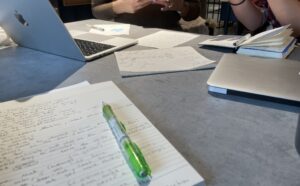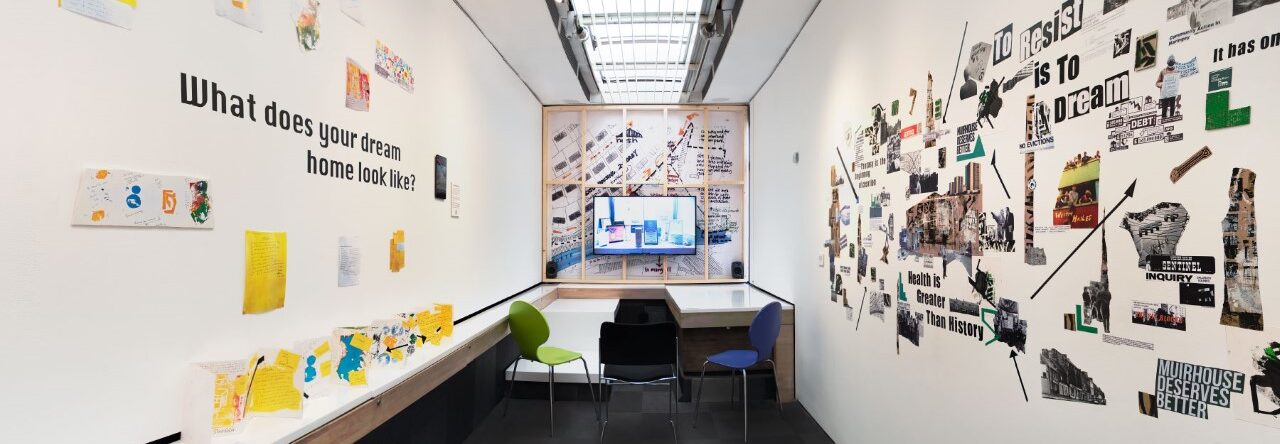(1) Identify your key responsibilities and list the main areas of work you have been involved in. Briefly highlight the skills and competencies that are relevant to this project/work area.
There were many central areas of the project. As a group we shared a lot of the workload and worked together on many of the tasks. At the same time we each focused in on different areas of this project. Early on in the project, up to about December 2022, a lot of the work was hypothetical. This meant that we were each researching the topic, developing our ideas, and learning how to bring our ideas together as a group. I worked on background research and participated in discussions around themes for the exhibition. I also visited the Travelling Gallery prior to install to help the group better understand the unique space we would be curating. I focused a lot on scheduling, contributing to the artwork selection process, as well as the development of curatorial rationale.
On the project overall there were several areas that were my main responsibilities. I took the lead on loaning artwork needed for the exhibition from the Universities’ Art Collection. This involved meeting with the Collections Registrar to discuss the requirements for, and writing, the loan request. Then following up, as we received the loan for one film, but later decided to use an additional film in an event. Another main responsibility for me was the budget. This involved organising the different fees, keeping track of any changes, and making sure to watch the limit. It meant working in relation to the finance department to make sure vendors and artists got paid, as well as making sure our group had the resources from finance to get travel fees reimbursed. In addition, I worked on scheduling for the group. For this I worked on action sheets, and made note of group goals and the timelines associated; also coordinating with the group for the dates they could invigilate the Travelling Gallery during the exhibition to ensure we each worked an equal amount.
Skills and Competencies
- Artwork Curation
- Communication
- Budgeting
- Scheduling
- Team Work
- Risk Management
(2) Looking ahead, list your key objectives for the GRP. 3-7 SMART (Specific, Measurable, Achievable, Relevant and Timed) objectives should be noted with realistic timescales and focused outcomes. The objectives should cover the project itself and your own role.
The main objectives for this project were:
- Archive Materials : A large part of getting ready for the exhibition was preparing the archive materials on housing experiences in the areas the exhibition would be travelling to that Joey Simons and Keira McLean would use in their workbook and wall montage. Research was to take place over winter break and early January. As a group we divided areas to research, looking into databases and archives (Glasgow Women’s Library). This was to be completed by mid-January, so the workbook could go to print by January 28th.
- Install : Installation of the exhibition into the Travelling Gallery took place February 6th and 7th, with the exhibition opening the next day. This meant ensuring all materials and objects arrived on time, and that the technology ran smoothly. For items like the wood for the stud wall, this meant timing it to have someone there for delivery. Additionally, working with the artists to have them see where their work would be and feel comfortable with the layout.
- Events : We had several events as a part of the exhibition: living archive workshop, Lucas Priest SoPC walk, and Winnie Herbstein Q&A film night. Each of these events needed planning, coordination, communication, advertisement, and a plan to evaluate; these aspects impacted the events and all went smoothly. The living archive workshop needed to be coordinated with the venue, as well as Joey Simons and Keira McLean ahead of the exhibition opening, on February 2nd. Lucas Priest’s SoPC walk took place February 9th, as we had to ensure the gallery was in the central Edinburgh area. The Winnie Herbstein Q&A film night required working with the host, Queer Film Night, and Winnie Herbstein to ensure everything ran smoothly, it took place February 20th.

Some of my individual objectives were:
- Budget : I worked to keep track of the budget and all changing fees. Making sure payments and reimbursements were made. As well as making sure that everything was handled in a timely manner.
- Evaluation : I worked to make sure we have evaluation plans for the exhibition and the events that took place. Feedback that could give us an idea of the audience that attended and how they responded to different aspects. While keeping in mind what we would like to learn from the audience as well as the interests of our partner organisations. The planning for this was done before any of the events, but required meetings to discuss findings later.
(3) Discursive self-reflection
Use this section to, 1) reflect upon the progress of the project to date (both as a whole and with regards to your own specific area/role). 2) Critically reflect upon your experience working with the group. Here you may consider your contribution so far, the value of your specific strengths and expertise, the effectiveness of group communications and your performance in group meetings. How might the group [have] enhance[d] its performance?
Overall, this project was exciting to be a part of and to be bringing up such an important topic. We were able to accomplish a lot: commissioning artists for the workbook, having three separate events, in addition to the exhibition itself. I also feel that the living archive aspect of the exhibition came together well. This bit took significant planning, especially technologically, and effort to maintain it throughout the exhibition – but it seemed to really allow visitors to connect personally with the space. The project came together to meet our goals, as we handled any difficulties as a group.
We had a really great group that worked really well together. At the beginning of this project we started by having a conversation about the background and experience each of us had that related to the project, and bringing that together. We split up tasks well and worked together to accomplish any challenges were handled as a group. A few times tasks remained undone as we were unsure who was in charge of it, but this to was handled in a timely manner. And when we realised that our budget would not allow us to hold Winnie Herbstein’s Sweat Equity, we worked as a group to find a solution. The resulting film screening Q&A worked out well.
We also had great communication, and no real hiccups or disagreements. Over the break when we were all in different places, we stayed in contact and made time for group meetings. When there were differing opinions we discussed the options and voted. This effective teamwork allowed for the project to run particularly smoothly, and eliminated any disjointedness that might have occurred with bad communication. It also meant that as a group we were able to split up to learn new skill sets through this project, while also supporting each other. I had little experience with budgeting, and took the lead on that. I learned a lot in this process, but had support from my group mates with more experience here. I am glad to have worked in this group; though we set a challenging plan for the exhibition, my colleagues and I were successful in the results.




Leave a Reply